Borneo: Deforestation and Discovery
Air Date: Week of February 9, 2007
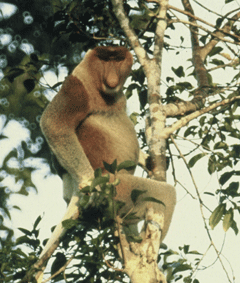
The proboscis monkey, seen here in Sarawak, Malaysia, is also known as the "Dutchman."((c) WWF-Canon/Jeffrey McNeely)
In Borneo, the demand for palm oil is threatening to destroy the habitat of some of the world’s most diverse wildlife. The World Wildlife Fund’s Adam Tomasek tells host Steve Curwood that his group has teamed up with the three countries that govern Borneo to implement a plan to protect the island nation’s diversity.
Transcript
CURWOOD: It’s Living on Earth. I’m Steve Curwood. Across the Java Sea from flood-ravaged Jakarta lies the island of Borneo. It’s home to some of the most diverse ecosystems in the world. In the last year alone, more than 50 new plant and animal species have been discovered in the Borneo rainforest. But much of that forest is falling to the chainsaw and the drive for agriculture. That’s why the three countries that share the island—Indonesia, Malaysia and Brunei—have just agreed to preserve as much as a third of Borneo from development. Adam Tomasek is the director of the Borneo and Sumatra Program for the World Wildlife Fund.
TOMASEK: The island itself holds an unbelievable amount of unique animals and plants. The more famous ones such as the orangutans, pigmy elephants, rhinoceros, the gibbons and other monkeys, the proboscis monkey, lizards and snakes galore.
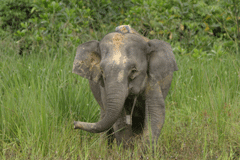
This pigmy elephant, "Roselis," is part of a satellite-based tracking study in the Danum Valley Conservation Area in Sabah (Borneo), Malaysia.((c) WWF-Canon/ A. Christy Williams)
TOMASEK: Well, they all have a very unique, um, adaptation that allows them to literally glide, most of them just being long appendages of skin that allow them to basically parachute down among the canopy of the trees. Many scientists now believe that these adaptations are such that these animals are able to glide as the most efficient way to move between large areas in the forest.
CURWOOD: Tell me about the monkey that the locals call the Dutchman.
TOMASEK: The Dutchman is also known as the proboscis monkey. And, ah they’re quite comical creatures. The males have a very large nose.

The proboscis monkey, seen here in Sarawak, Malaysia, is also known as the "Dutchman."((c) WWF-Canon/Jeffrey McNeely)
TOMASEK: That’s right.
CURWOOD: The male monkeys look like, well, a rather old man who’s, you know, maybe had an awful lot of beer over his lifetime.
TOMASEK: (laughs) Local rumor, local tale, has it that that is exactly why it came to be known as the Dutchman.
CURWOOD: But the scientific reason it has such a big belly is.
TOMASEK: More has to do with the adaptation to the food that it eats. They eat a lot of leaves and some fruit. The actual physical adaptation is such that it has a stomach similar to a ruminant, or a, I guess a cow that we’d be familiar here where there are different chambers in the stomach that allow it to digest the high cellulose content of a lot of leaves.
CURWOOD: I understand that scientists have found more than 50 new species of plants and animals on Borneo in just this last year alone. What kind of things are they finding?

Adam Tomasek is the WWF's Director for the Borneo-Sumatra Program. (Photo: WWF)
CURWOOD: Now, what’s been the effect of development on the search for new creatures on Borneo? I understand it’s quite threatened- the rainforest is disappearing rapidly.
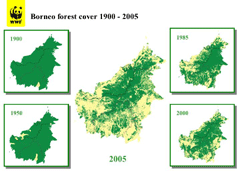
The forest cover on Borneo is quickly disappearing (Photo: WWF)
Development also means that there is a world of attention: financial attention, scientific attention, political and economic attention that’s being focused on the island itself as well. So, we’re looking quite carefully at the impacts of development, which really relates to the issues around palm oil plantations. Palm oil itself is one of the largest drivers of forest loss and forest conversion on Borneo as well as other parts of Indonesia and Malaysia. Indonesia and Malaysia are the two countries that produce the most amount of palm oil in the world, supply around 85 percent or so. And both governments in the last year have announced very aggressive expansion plans.
CURWOOD: What’s the palm oil used for?
TOMASEK: Palm oil is a rather ubiquitous substance. It’s found in a lot of the snacks that we consume on a daily basis; everything from cookies and microwave popcorn to, ah, candy bars. It’s also used in different soaps and shampoos. And we’ve seen a major spike in the global demand for looking at palm oil as a major component of biofuels. It’s quite useful in a lot of different products which really means that is has really large market demand.
CURWOOD: Now I hear that as the forests are cleared for such projects as growing palm oil, that the orangutans have been especially displaced by all of this development.
TOMASEK: Well, orangutans are very sensitive to their habitats. They’re the world’s largest tree dwelling animal. Um, they’re the only one of the great apes that is more arboreal than it is terrestrial as you compare them to the gorillas in particular in Africa. Um, so they’re extremely dependent on trees and healthy forest systems for their food and forage and nesting habits.
CURWOOD: I understand that there’s a three-government agreement to protect what you at the World Wildlife Fund call the "heart of Borneo." Tell me about this agreement.
TOMASEK: The agreement is what we refer to as the Heart of Borneo Declaration. And it was officially launched by the governments of Brunei, Malaysia, and Indonesia just last month. It is analogous to what we’ve seen governments in the Amazon and the Congo Basin over the last few years launch. We’re quite hopeful that this is the real first signs of how the three governments are willing to cooperate to supercede national priorities and, and really look at the island as a single entity that they care deeply about. That they’re committed to actually find solutions to the most pressing of problems.
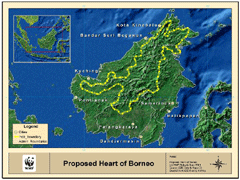
Proposed Heart of Borneo preserve (Photo: WWF)
CURWOOD: You know, what’s the thing that really strikes you about this place? Perhaps a personal story.
TOMASEK: In the middle part of last year we took a group of people from around the world out to experience Borneo. And we were in the Danum Valley. As we woke up in the morning I wandered off before breakfast to have some alone time with all of the delightful sounds of the, ah, forest. And I was sitting on the riverbank looking up as the gibbons started doing their morning calls. The mist was rising up off the river.
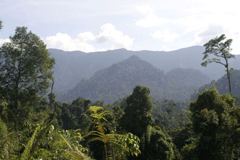
The notheast tip of Borneo, part of the Malaysian state of Sabah. ((c) WWF-Canon/ A. Christy Williams)
CURWOOD: Adam Tomasek is the director of the Borneo and Sumatra Program for the World Wildlife Fund. Thank you so much, sir.
TOMASEK: Thank you very much.
Links
Living on Earth wants to hear from you!
Living on Earth
62 Calef Highway, Suite 212
Lee, NH 03861
Telephone: 617-287-4121
E-mail: comments@loe.org
Newsletter [Click here]
Donate to Living on Earth!
Living on Earth is an independent media program and relies entirely on contributions from listeners and institutions supporting public service. Please donate now to preserve an independent environmental voice.
NewsletterLiving on Earth offers a weekly delivery of the show's rundown to your mailbox. Sign up for our newsletter today!
 Sailors For The Sea: Be the change you want to sea.
Sailors For The Sea: Be the change you want to sea.
 Creating positive outcomes for future generations.
Creating positive outcomes for future generations.
 Innovating to make the world a better, more sustainable place to live. Listen to the race to 9 billion
Innovating to make the world a better, more sustainable place to live. Listen to the race to 9 billion
 The Grantham Foundation for the Protection of the Environment: Committed to protecting and improving the health of the global environment.
The Grantham Foundation for the Protection of the Environment: Committed to protecting and improving the health of the global environment.
 Contribute to Living on Earth and receive, as our gift to you, an archival print of one of Mark Seth Lender's extraordinary wildlife photographs. Follow the link to see Mark's current collection of photographs.
Contribute to Living on Earth and receive, as our gift to you, an archival print of one of Mark Seth Lender's extraordinary wildlife photographs. Follow the link to see Mark's current collection of photographs.
 Buy a signed copy of Mark Seth Lender's book Smeagull the Seagull & support Living on Earth
Buy a signed copy of Mark Seth Lender's book Smeagull the Seagull & support Living on Earth

